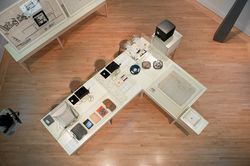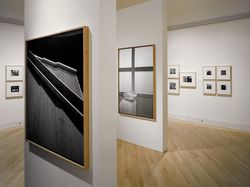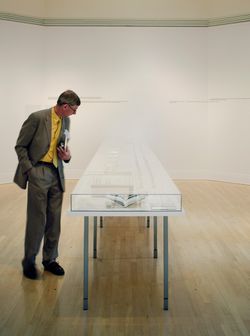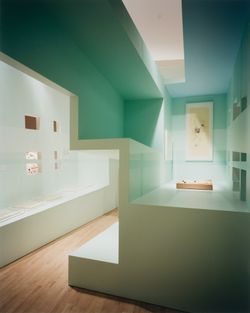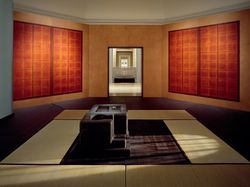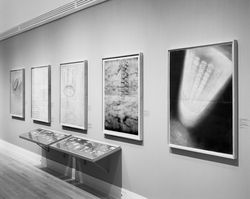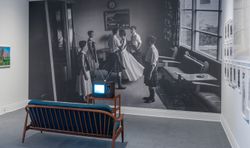The exhibition addresses a central and timely aspect of the work of Carlo Scarpa: its distinctive approach to contending with the layers of history that mark the fabric of a city and a building. In addressing Scarpa’s ability to weave new work into, and often out of, the disparate fragments of the old, Carlo Scarpa, Architect: Intervening with History begins to unravel(...)
Main galleries
26 May 1999 to 31 October 1999
Carlo Scarpa, Architect: Intervening with History
Actions:
Description:
The exhibition addresses a central and timely aspect of the work of Carlo Scarpa: its distinctive approach to contending with the layers of history that mark the fabric of a city and a building. In addressing Scarpa’s ability to weave new work into, and often out of, the disparate fragments of the old, Carlo Scarpa, Architect: Intervening with History begins to unravel(...)
Main galleries
The internet was invented as the ultimate standard; it is literally made of rules. Online content abides by some intentional and unintentional rules, and texture, smell, weight, flavour, and time are flattened together for the screen. Computers appear to instantaneously transform objects into images and meaning into information. 404 ERROR: The object is not online brings(...)
Octagonal gallery
11 November 2010 to 6 February 2011
404 ERROR: The object is not online
Actions:
Description:
The internet was invented as the ultimate standard; it is literally made of rules. Online content abides by some intentional and unintentional rules, and texture, smell, weight, flavour, and time are flattened together for the screen. Computers appear to instantaneously transform objects into images and meaning into information. 404 ERROR: The object is not online brings(...)
Octagonal gallery
Richard Pare – Tadao Ando: The Colours of Light explores the relationship between the work of Japanese architect Tadao Ando, one of the major protagonists of a new sense of poetry in the architecture of our time, and the work of British photographer Richard Pare, pioneer in the study of the place of photography in the representation of architecture. Rather than to(...)
Octagonal gallery
26 March 1997 to 1 June 1997
Richard Pare – Tadao Ando: The Colours of Light
Actions:
Description:
Richard Pare – Tadao Ando: The Colours of Light explores the relationship between the work of Japanese architect Tadao Ando, one of the major protagonists of a new sense of poetry in the architecture of our time, and the work of British photographer Richard Pare, pioneer in the study of the place of photography in the representation of architecture. Rather than to(...)
Octagonal gallery
Learning from… Ruscha and Venturi Scott Brown, 1962–1977 examines the relationship between the seminal illustrated books by artist Edward Ruscha and architects Robert Venturi and Denise Scott Brown that deal with the architecture and urbanism of the everyday in Los Angeles and Las Vegas during the 1960s and 1970s. Ruscha’s Every Building on the Sunset Strip and Venturi(...)
Octagonal gallery
31 March 2004 to 30 May 2004
Learning from… Ruscha and Venturi Scott Brown, 1962–1977
Actions:
Description:
Learning from… Ruscha and Venturi Scott Brown, 1962–1977 examines the relationship between the seminal illustrated books by artist Edward Ruscha and architects Robert Venturi and Denise Scott Brown that deal with the architecture and urbanism of the everyday in Los Angeles and Las Vegas during the 1960s and 1970s. Ruscha’s Every Building on the Sunset Strip and Venturi(...)
Octagonal gallery
*Cities of Artificial Excavation: The Work of Peter Eisenman, 1978–1988* explores how American architect and writer Peter Eisenman questioned the concept of “site,” and demonstrates the importance of drawing and modelmaking in generating his ideas. The exhibition reveals the richness and complexity of the design process by looking carefully at Eisenman’s drawings and(...)
Main galleries
2 March 1994 to 19 June 1994
Cities of Artificial Excavation: The Work of Peter Eisenman, 1978-1988
Actions:
Description:
*Cities of Artificial Excavation: The Work of Peter Eisenman, 1978–1988* explores how American architect and writer Peter Eisenman questioned the concept of “site,” and demonstrates the importance of drawing and modelmaking in generating his ideas. The exhibition reveals the richness and complexity of the design process by looking carefully at Eisenman’s drawings and(...)
Main galleries
According to a Chinese legend well-known in Japan, a giant katsura tree was planted on the moon, inspiring the proverb, “We can see the katsura on the moon with our eyes, but we cannot touch it with our hands.” The saying celebrates the quest for an absolute and is a fitting epigraph for Departure for Katsura, which pursues issues of self-identity and personal(...)
Octagonal gallery, hall cases, and Sottsass Room
9 December 1998 to 28 March 1999
Irene F. Whittome: Departure for Katsura
Actions:
Description:
According to a Chinese legend well-known in Japan, a giant katsura tree was planted on the moon, inspiring the proverb, “We can see the katsura on the moon with our eyes, but we cannot touch it with our hands.” The saying celebrates the quest for an absolute and is a fitting epigraph for Departure for Katsura, which pursues issues of self-identity and personal(...)
Octagonal gallery, hall cases, and Sottsass Room
The exhibition explores one of the most adventurous and influential moments in the history of architecture: the explosion of invention and ideas that followed the October Revolution in Russia. The Soviet avant-garde architects were productivist as much as aesthetic in their concerns; they saw architecture and the arts as one, and they were committed to bringing design(...)
Main galleries
19 June 1991 to 8 September 1991
Architectural Drawings of the Russian Avant-Garde, 1917-1935
Actions:
Description:
The exhibition explores one of the most adventurous and influential moments in the history of architecture: the explosion of invention and ideas that followed the October Revolution in Russia. The Soviet avant-garde architects were productivist as much as aesthetic in their concerns; they saw architecture and the arts as one, and they were committed to bringing design(...)
Main galleries
graphic materials
DR2012:0012:050
Description:
File containing assorted posters and mailouts for the following events, etc.: - poster for Quebec release of For a few dollars more; - mailout for Robert Rauschenberg exhibition at Sonnabend Gallery; - poster for Robert Rauchenberg's White paintings at Leo Castelli Gallery; - posters for Melvin Charney: other monuments, six works exhibition at the Art Gallery of Ontario; - poster for Between observation and intervention: the painted photographs of Melvin Charney; - mailout for Frank Stella lithographs at Castelli Graphics [Leo Castelli Gallery]; - invitation for the opening of Montréal, plus ou moins?; - poster for Edward Rushca Liquid word series at the Alexandre Iolas Gallery; - poster for a conference at the Technische Hogeschool Eindhoven in which Melvin Charney participated; - poster and unfolded brochure for Corridart; - poster for James Rosenquist exhibition at Leo Castelli Gallery; - poster for Melvin Charney's exhibition Other monuments: 1970-1976 at Gund Hall, Harvard University; - poster for James Rosenquist exhibition at Leo Castelli Gallery; - poster for Jasper Johns exhibition at Leo Castelli Gallery; - colour and black-and-white publication dummies for a book about Melvin Charney by the Musée d'art contemporain de Montréal; - poster for exhibition for the 6th residential course of the Labratorio internazionale di Architettura e Disegno Urbano.
between 1965 and 2008, predominant 1976-1981
Posters and mailouts for various events
Actions:
DR2012:0012:050
Description:
File containing assorted posters and mailouts for the following events, etc.: - poster for Quebec release of For a few dollars more; - mailout for Robert Rauschenberg exhibition at Sonnabend Gallery; - poster for Robert Rauchenberg's White paintings at Leo Castelli Gallery; - posters for Melvin Charney: other monuments, six works exhibition at the Art Gallery of Ontario; - poster for Between observation and intervention: the painted photographs of Melvin Charney; - mailout for Frank Stella lithographs at Castelli Graphics [Leo Castelli Gallery]; - invitation for the opening of Montréal, plus ou moins?; - poster for Edward Rushca Liquid word series at the Alexandre Iolas Gallery; - poster for a conference at the Technische Hogeschool Eindhoven in which Melvin Charney participated; - poster and unfolded brochure for Corridart; - poster for James Rosenquist exhibition at Leo Castelli Gallery; - poster for Melvin Charney's exhibition Other monuments: 1970-1976 at Gund Hall, Harvard University; - poster for James Rosenquist exhibition at Leo Castelli Gallery; - poster for Jasper Johns exhibition at Leo Castelli Gallery; - colour and black-and-white publication dummies for a book about Melvin Charney by the Musée d'art contemporain de Montréal; - poster for exhibition for the 6th residential course of the Labratorio internazionale di Architettura e Disegno Urbano.
graphic materials
between 1965 and 2008, predominant 1976-1981
In an age of unprecedented human impact on the planet, certain countries stand out for their privileged positions and the complexity of their relationships with the land. Stories about Canada closely follow the discovery and appropriation of vast and varied natural resources as well as changing ideas of the proper relationship between people and their environment.(...)
16 November 2016 to 9 April 2017
It’s All Happening So Fast
Actions:
Description:
In an age of unprecedented human impact on the planet, certain countries stand out for their privileged positions and the complexity of their relationships with the land. Stories about Canada closely follow the discovery and appropriation of vast and varied natural resources as well as changing ideas of the proper relationship between people and their environment.(...)
drawings
DR2006:0003
Description:
Le collage intitulé " Galerie de la grande architecture canadienne " a été produit dans le contexte de l'exposition " Canada-Trajectoires 1973 " présentée au Musée national d'art moderne de la ville de Paris au cours de l'été 1973. Le collage, appliqué sur papier cartonné, représente une sélection de textes et d'images d'œuvres exposées par Melvin Charney lors de cette exposition. L'objectif de l'exposition "Canada-Trajectoires 1973 " était de réunir des artistes ou des regroupements d'artistes engagés dans des discours critiques et de présenter leur travail non pas tant comme des oeuvres d'art mais plutôt " comme symptômes d'un certain climat ." (1) Selon le catalogue de l'exposition, et les divers comptes rendus qui en ont été fait dans la presse spécialisée, celle-ci était divisée en cinq sections. Quatre de ces sections étaient consacrées à des médiums spécifiques : art céramique, vidéo, peinture et sculpture, cinéma. Une cinquième section présentait des œuvres produites par des collectif d'artistes quelques soit le médium employé: galerie coopérative, coop d'artistes, workshop, banques d'images. C'est dans cette dernière section que Melvin Charney présenta trois projets créé avec l'assistance d'un groupe d'"action photographique", soit un "pavillon d'exposition" réalisé en 1969, une "monument à l'aviation" (1969) et "une galerie de la grande architecture" (1973). Dans un texte de Melvin Charney publié dans le catalogue de l'exposition, ces trois projets furent présentés sous l'intitulé "Quelques monuments nationaux". Le collage incorpore en une première strate collée obliquement par rapport au sens du carton d'œuvre, une image (en partie rognée), un texte manifeste (en partie coupée) et un intitulé. Ces trois éléments de toutes évidences se rapportent à L'ensemble des trois projets présenté par Charney. Sur une seconde strate, collée dans le sens du carton d'œuvres, Charney a collé des textes et des images se rapportant à deux des projets soit "une galerie de la grande architecture" (image et texte 25, 26 31 et 34, et monument à l'aviation, image et texte 50. Le collage est signé et daté en bas à droite. Des indications d'intercalation d'illustration au crayon graphite, - avec la mention "cut line" - détermine à même le carton d'œuvre, une zone regroupant l'ensemble des textes et des images collés. Au dos du collage figure à nouveau la signature de Charney et une numéro d'inventaire renvoyant possiblement à un catalogue constitué par Charney de son œuvre : "MC 1973 ? 02". Ce collage a servi de maquette pour la production d'une affiche publicisant l'exposition, ce qui explique la présence d'indications d'intercalation d'illustrations - une donnée signalant en règle générale que l'œuvre a été produite pour être publiée. (2) Ceci dit on ne sait pas si celle-ci fut effectivement tirée (nous n'en connaissons aucun exemplaire) avant, pendant ou après l'exposition. Cet aspect de l'historique de cette œuvre reste encore au moment où nous écrivons, à éclaircir. On peut établir toutefois avec certitude que cette œuvre, ou l'affiche qui en fut éventuellement tirée, a servi à produire la mise en page d'un article de Melvin Charney publié en avril 1974 dans la revue britannique Architectural Design. Un transparent a sans doute été pris du collage puis envoyé avec l'article de Charney à l'éditeur. Ce dernier a, à son tour, cadré l'image en fonction des indications d'intercalation d'illustrations latérales et supérieure,- on observe que le 3 de 1973 est bel et bien coupé - puis a éliminé les trois quart inférieur pour y placer le texte de l'article. La présence dans l'article publié du nom du musée d'art moderne de la ville de Paris - section arc, et son absence dans le collage est du à une perte. Un examen attentif révèle des marques sans doute de colle pour la bandelette de papier. Dans cet article publié en anglais Charney. 1- Suzanne Page, Canada trajectoires 73 : Musée d'art moderne de la ville de Paris, [Montréal?] : Publié par les Éditions Médiart pour le compte du Conseil des arts du Canada, [1973], [introduction] 2- Information fournie par l,artiste; voir aussi la légende de l'œuvre lors de sa reproduction dans un catalogue en 2000 où elle est décrite comme étant une maquette pour une affiche en offset sur papier.
1973
Some national monuments, Canada trajectories
Actions:
DR2006:0003
Description:
Le collage intitulé " Galerie de la grande architecture canadienne " a été produit dans le contexte de l'exposition " Canada-Trajectoires 1973 " présentée au Musée national d'art moderne de la ville de Paris au cours de l'été 1973. Le collage, appliqué sur papier cartonné, représente une sélection de textes et d'images d'œuvres exposées par Melvin Charney lors de cette exposition. L'objectif de l'exposition "Canada-Trajectoires 1973 " était de réunir des artistes ou des regroupements d'artistes engagés dans des discours critiques et de présenter leur travail non pas tant comme des oeuvres d'art mais plutôt " comme symptômes d'un certain climat ." (1) Selon le catalogue de l'exposition, et les divers comptes rendus qui en ont été fait dans la presse spécialisée, celle-ci était divisée en cinq sections. Quatre de ces sections étaient consacrées à des médiums spécifiques : art céramique, vidéo, peinture et sculpture, cinéma. Une cinquième section présentait des œuvres produites par des collectif d'artistes quelques soit le médium employé: galerie coopérative, coop d'artistes, workshop, banques d'images. C'est dans cette dernière section que Melvin Charney présenta trois projets créé avec l'assistance d'un groupe d'"action photographique", soit un "pavillon d'exposition" réalisé en 1969, une "monument à l'aviation" (1969) et "une galerie de la grande architecture" (1973). Dans un texte de Melvin Charney publié dans le catalogue de l'exposition, ces trois projets furent présentés sous l'intitulé "Quelques monuments nationaux". Le collage incorpore en une première strate collée obliquement par rapport au sens du carton d'œuvre, une image (en partie rognée), un texte manifeste (en partie coupée) et un intitulé. Ces trois éléments de toutes évidences se rapportent à L'ensemble des trois projets présenté par Charney. Sur une seconde strate, collée dans le sens du carton d'œuvres, Charney a collé des textes et des images se rapportant à deux des projets soit "une galerie de la grande architecture" (image et texte 25, 26 31 et 34, et monument à l'aviation, image et texte 50. Le collage est signé et daté en bas à droite. Des indications d'intercalation d'illustration au crayon graphite, - avec la mention "cut line" - détermine à même le carton d'œuvre, une zone regroupant l'ensemble des textes et des images collés. Au dos du collage figure à nouveau la signature de Charney et une numéro d'inventaire renvoyant possiblement à un catalogue constitué par Charney de son œuvre : "MC 1973 ? 02". Ce collage a servi de maquette pour la production d'une affiche publicisant l'exposition, ce qui explique la présence d'indications d'intercalation d'illustrations - une donnée signalant en règle générale que l'œuvre a été produite pour être publiée. (2) Ceci dit on ne sait pas si celle-ci fut effectivement tirée (nous n'en connaissons aucun exemplaire) avant, pendant ou après l'exposition. Cet aspect de l'historique de cette œuvre reste encore au moment où nous écrivons, à éclaircir. On peut établir toutefois avec certitude que cette œuvre, ou l'affiche qui en fut éventuellement tirée, a servi à produire la mise en page d'un article de Melvin Charney publié en avril 1974 dans la revue britannique Architectural Design. Un transparent a sans doute été pris du collage puis envoyé avec l'article de Charney à l'éditeur. Ce dernier a, à son tour, cadré l'image en fonction des indications d'intercalation d'illustrations latérales et supérieure,- on observe que le 3 de 1973 est bel et bien coupé - puis a éliminé les trois quart inférieur pour y placer le texte de l'article. La présence dans l'article publié du nom du musée d'art moderne de la ville de Paris - section arc, et son absence dans le collage est du à une perte. Un examen attentif révèle des marques sans doute de colle pour la bandelette de papier. Dans cet article publié en anglais Charney. 1- Suzanne Page, Canada trajectoires 73 : Musée d'art moderne de la ville de Paris, [Montréal?] : Publié par les Éditions Médiart pour le compte du Conseil des arts du Canada, [1973], [introduction] 2- Information fournie par l,artiste; voir aussi la légende de l'œuvre lors de sa reproduction dans un catalogue en 2000 où elle est décrite comme étant une maquette pour une affiche en offset sur papier.
drawings
1973

